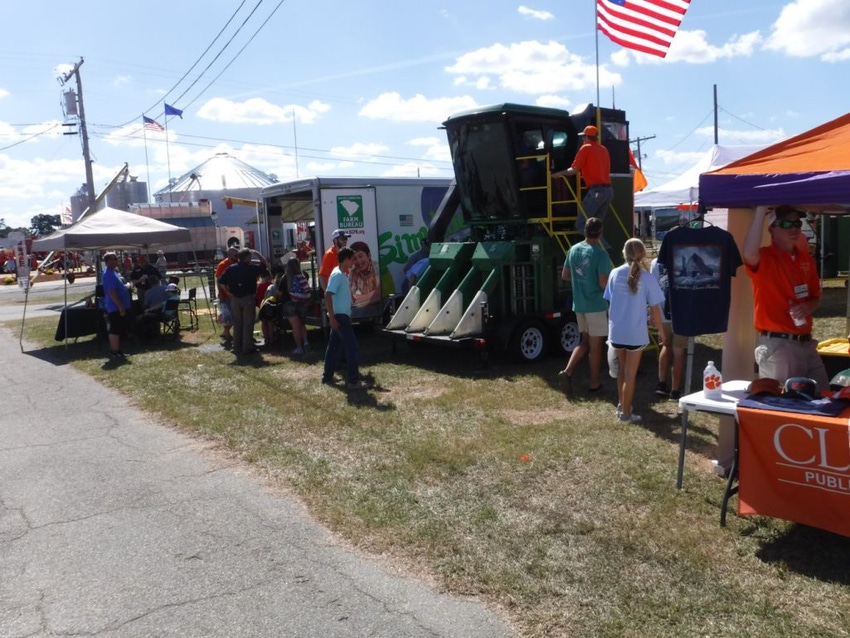November 15, 2016

A group of Clemson University students is taking its cotton picking show on the road to raise awareness about agriculture.
The students are in the Clemson agricultural mechanization and business program and have redesigned a mechanical cotton picker to use to teach others about cotton harvesting. Hunter Massey, a lecturer for the Clemson Agricultural Sciences department and a graduate student in plant and environmental sciences, is directing the project.
“We call this our ‘mobile cotton harvester’,” Massey said. “We plan to take it to high school programs, expos and other events to create awareness about agriculture and our agricultural programs here at Clemson.”
Students built the mobile cotton harvester “from the ground up” to demonstrate cotton harvesting, Massey said. A monitor located in the cab shows video of a cotton field. Riders can crank up the harvester, watch the heads engage, the spindles turn and cotton move up the suction duct to the basket, all while simulating driving down rows of cotton. The harvester is a Clemson Capstone project. A Capstone research project can be chosen in place of comprehensive exams as a final research project prior to graduation.
John Platte, a sophomore from Aiken, was responsible for wiring the cab for the air conditioning system.
“It was a lot of fun,” Platte said. “I liked being able to apply what I have learned in the classroom. By taking a fabrication class, I knew what tools to use, what the different metals were and things like that. The biggest challenge I faced was having patience. It took a long time, determining what hooks up to what and things like that.”
The air conditioning unit is located in a bin on the back of the harvester’s cab. Wired fan units pump cold air in to the cab. Platte had to create a duct system from the air conditioning unit in to the cab.
“This (harvester) is such a unique attention-getter,” Platte said. “It’s a really cool thing. It was fun working on it and learning how to put it together.”
Other students who took charge of the project are: Michael Kule, a sophomore from Aiken; Charlie Westbrook, a senior from Rock Hill; and Brennan Teddy, a junior from Shelby, North Carolina. Work on the harvester began in 2015 when students made the spindles turn to cause the mobile harvester to appear as if it was really picking cotton.
“This is the third group of students who have worked on this harvester,” Massey said. “This project has encouraged teamwork and has allowed the students to bond and work together to achieve a common goal.”
The harvester recently went on its maiden voyage to the Sunbelt Ag Expo in Moutrie, Georgia. Massey and students are eager for the exhibit to travel to more places and spread the word about agriculture. (Contact Massey at [email protected] for information on how to have the mobile cotton picker exhibit appear at your event.)
According to Massey, about 200 students are enrolled in the Clemson agricultural mechanization and business program.
“Our program has a 100 percent rate for job placement of students after they graduate,” Massey said. “This is a field with a high demand for employees.”
The demand for employees in the agriculture sector is expected to rise. A 2015 study supported in part by Clemson’s Public Service Activities division shows the highly diverse cluster of industries that make up agribusiness, including agriculture and forestry, account for roughly $41.7 billion in economic impact and more than 212,000 jobs in South Carolina.
In addition to agriculture mechanization and business, other careers in agriculture include positions in: agribusiness, agricultural education, agriscience, animal and veterinary sciences, packaging science, horticulture, ecology, entomology, forest resources, forest resource management, food science, food technology and wildlife and fisheries biology; as well as environmental and natural resources, pre-veterinary medicine and turfgrass research. According to the U.S. Department of Labor Bureau of Labor Statistics, employment of scientists in the agricultural sector is projected to grow 5 percent from 2014 to 2024.
A report from the Bureau of Labor Statistics shows median annual pay for agricultural scientists for 2015 was $62,470. Agricultural scientists need at least bachelor’s degrees to work in this industry.
You May Also Like




